

This article is only available to Macro Hive subscribers. Sign-up to receive world-class macro analysis with a daily curated newsletter, podcast, original content from award-winning researchers, cross market strategy, equity insights, trade ideas, crypto flow frameworks, academic paper summaries, explanation and analysis of market-moving events, community investor chat room, and more.
We track scheduled flights (what’s planned) and tracked flights (what took off) from a sample of the largest airports across the world.
Looking at data up to 15 August:
- Global flights are at 86% of 2019 levels, though the number of flights has stalled around 107k/day after having peaked five weeks ago (Chart 1). Historic seasonality would suggest flight numbers will continue to decrease.
- Asia’s impressive recovery, which outperformed the RoW through Q2, may be ending (Chart 2). Meanwhile, European flights have already seemingly topped, while they have seen a bounce in America.
- Shanghai (+15.0% WoW) led the way for the third week straight (Chart 4); it is still some way from returning to COVID-19 norms. Beijing (+1.1% WoW) is following a similar path up from its bottom. However, recent rising COVID-19 cases in the country may present a headwind.
- Elsewhere, travellers are heading for the complaints desk, not the sky; Heathrow Airport (-0.2% WoW) is extending its traveller cap. It means a maximum of 100,000 passengers can depart each day until 29 October. It was initially expected to be lifted on 11 September. Things are not much better in New York (+3.2% WoW) which is doing similar.
- For more information on recent changes in COVID cases, please see our weekend report.
Information on long-term movements in flight data is available below.
